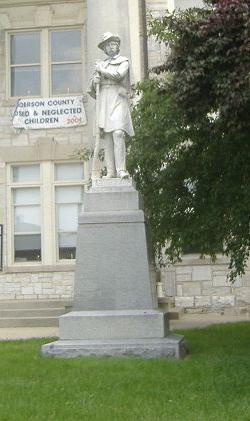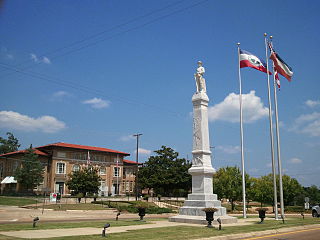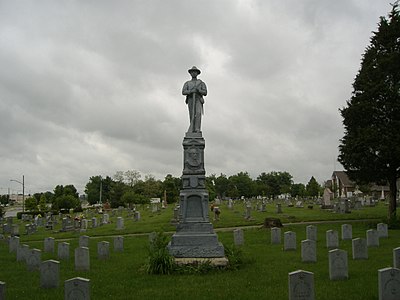
The Confederate Martyrs Monument at the Jeffersontown City Cemetery in Jeffersontown, Kentucky, marks where four Confederate soldiers were executed "without cause or trial". Their execution was under Order 59, created by Union General Stephen G. Burbridge, known as "Butcher Burbridge" in Kentucky, which called for the execution of four Confederate prisoners for every unarmed Union citizen killed. The total number of executions performed as a result of this order was fifty. The four soldiers commemorated on the stone were Wilson P. Lilly, Rev. Sherwood Hatley, Lindsay Duke Buckner and M. Blincoe.

The John Hunt Morgan Memorial in Lexington, Kentucky, is a monument created during the Jim Crow era, as a tribute to Confederate General John Hunt Morgan, who was from Lexington and is buried in Lexington Cemetery. The monument was originally situated on the Courthouse Lawn at the junction of North Upper and East Main Street, but was moved to Lexington Cemetery in 2018.

The Confederate Monument in Cynthiana is located on the outer edge of Cynthiana, Kentucky in Battle Grove Cemetery. It was the first monument to the Confederate States of America dedicated in the State of Kentucky, and long believed to be the first Confederate memorial anywhere. Due to the 32nd Indiana Monument having been moved from its original location, the Cynthiana monument is the oldest Civil War monument still standing at its original location, where the second Battle of Cynthiana started, in the then-new town cemetery.

The Confederate Monument in Danville, originally located between Centre College and the First Presbyterian Church at the corner of Main and College Streets in Danville, Kentucky, was a monument dedicated to the Confederate States of America that is on the National Register of Historic Places. The monument was dedicated in 1910 by the surviving veterans of the Confederacy of Boyle County, Kentucky and the Kate Morrison Breckinridge Chapter of the United Daughters of the Confederacy (UDC). In 2021, it was relocated to a museum in Meade County, Kentucky.

The Confederate Monument in Frankfort is placed within a circle of the graves of 68 Confederate soldiers in Frankfort Cemetery in Kentucky. The statue depicts a life size Confederate soldier standing ready, carved from white Carrara marble and standing atop a granite pedestal on a limestone base. A flagpole displays the first flag of the Confederacy with seven stars. The monument was erected by Daughters of the Confederacy and unveiled in 1892.

The Confederate Monument in Lawrenceburg, Kentucky is an 8-foot-tall (2.4 m) carved granite figure on a granite pedestal which was built in 1894 by the Kentucky Women's Monumental Association, a predecessor of the United Daughters of the Confederacy, an organization founded in that year. Its governing body is the government of Lawrenceburg.

The Lloyd Tilghman Memorial is a statue located in Paducah Kentucky, of Lloyd Tilghman, a brigadier general for the Confederate States of America who died at the Battle of Champion Hill in May 1863.

The Confederate Soldier Monument in Caldwell County, Kentucky is a historic statue located on the Caldwell County Courthouse south lawn in the county seat of Princeton, Kentucky, United States. It was erected in 1912 by the Tom Johnson Chapter No. 886 of the United Daughters of the Confederacy (UDC).

The Confederate Monument in Murray is a statue located in the northeast corner of the Calloway County Courthouse in Murray, Kentucky. It commemorates the 800 citizens of the county who served in the Confederate Army during the American Civil War, and is one of several Confederate monuments in Kentucky featuring Robert E. Lee. There is another one in Bardstown KY. Despite recent controversy, the Calloway County Fiscal Court voted to keep the statue on its grounds in July 2020.

The Confederate Monument in Owensboro, Ky., was a 16-foot-tall, two-part object — a 7-foot-tall bronze sculpture atop a 9-foot-tall granite pedestal — located at the southwest corner of the Daviess County Courthouse lawn, at the intersection of Third and Frederica Streets, in Owensboro, Kentucky. Nearly 122 years after the monument was dedicated in September 1900, the monument was dismantled in 2022, beginning with the removal of the sculpture in May 2022; the sculpture was placed in storage, pending a decision on what to do with it.

The Confederate Memorial includes a 6-foot-tall (1.8 m) Confederate soldier statue atop an arch anchored in the Fulton, Kentucky Fairview Cemetery. Funded in 1902 by the Colonel Ed Crossland Chapter No. 347 of the United Daughters of the Confederacy, the historic monument is the only such monument in Kentucky to feature an arched base, made of rough-hewn limestone.

The Confederate Memorial in Nicholasville is a historic statue created in the Jim Crow era and located on the Jessamine County courthouse lawn in Nicholasville, Kentucky, ten miles south of Lexington, Kentucky.

Myrtle Hill Cemetery is the second oldest cemetery in the city of Rome, Georgia. The cemetery is at the confluence of the Etowah River and Oostanaula River and to the south of downtown Rome across the South Broad Street bridge.
Confederate monuments and memorials in the United States include public displays and symbols of the Confederate States of America (CSA), Confederate leaders, or Confederate soldiers of the American Civil War. Many monuments and memorials have been or will be removed under great controversy. Part of the commemoration of the American Civil War, these symbols include monuments and statues, flags, holidays and other observances, and the names of schools, roads, parks, bridges, buildings, counties, cities, lakes, dams, military bases, and other public structures. In a December 2018 special report, Smithsonian Magazine stated, "over the past ten years, taxpayers have directed at least $40 million to Confederate monuments—statues, homes, parks, museums, libraries, and cemeteries—and to Confederate heritage organizations."

Appomattox is a bronze statue commemorating soldiers from Alexandria, Virginia, who had died while fighting for the Confederacy during the American Civil War. The memorial was located in the center of the intersection of South Washington Street and Prince Street in the Old Town neighborhood of Alexandria.

A Ladies' Memorial Association (LMA) is a type of organization for women that sprang up all over the American South in the years after the American Civil War. Typically, these were organizations by and for women, whose goal was to raise monuments in Confederate soldiers honor. Their immediate goal, of providing decent burial for soldiers, was joined with the desire to commemorate the sacrifices of Southerners and to propagate the Lost Cause of the Confederacy. Between 1865 and 1900, these associations were a formidable force in Southern culture, establishing cemeteries and raising large monuments often in very conspicuous places, and helped unite white Southerners in an ideology at once therapeutic and political.

The Rankin County Confederate Monument is a war memorial located on the downtown square of Brandon, Mississippi, at the intersection of Government and North streets. The monument was erected in 1907 by the Brandon Chapter of the United Daughters of the Confederacy. The monument was listed on the National Register of Historic Places on August 1, 1997.

There are more than 160 monuments and memorials to the Confederate States of America and associated figures that have been removed from public spaces in the United States, all but five of which have been since 2015. Some have been removed by state and local governments; others have been torn down by protestors.




















